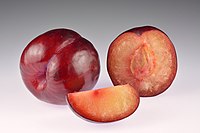
Photo from wikipedia
The European plum (Prunus domestica L.) is a worldwide distributed tree species. Italy has an ample number of traditional varieties, but many are neglected and at risk of extinction. This… Click to show full abstract
The European plum (Prunus domestica L.) is a worldwide distributed tree species. Italy has an ample number of traditional varieties, but many are neglected and at risk of extinction. This germplasm is still cultivated in rural areas in spite of the EU-28 crisis of the stone fruit sector. Traditional European plum varieties remain poorly characterized, strongly limiting their promotion in local markets, use for farm diversification, and exploitation for local gastronomic products. In this study, we carried out an investigation of the morphological and genetic diversity present in an ex-situ collection of 29 traditional varieties of P. domestica of the Campania region (Southern Italy). The combination of five continuous and five categorical fruit traits allowed us to phenotypically distinguish all the varieties. Similarly, the Simple Sequence Repeats (SSRs) employed (five genomic and five deriving from Expressed Sequence Tags) identified a unique molecular profile for each variety. Moreover, the data indicated that the phenotypic and molecular investigations provided different clustering, suggesting that the two analyses sampled different sources of diversity. The number and the distribution of the scored phenotypes as well as the indices of genetic diversity imply the presence of a wide-ranging variation, which may sustain the development of high-value, niche market products. Our work provided evidence that the implementation of measures for a combination of ex-situ and on-farm conservation of traditional European plum varieties should be preferred to avoid the loss of an ample diversity.
Journal Title: Sustainability
Year Published: 2019
Link to full text (if available)
Share on Social Media: Sign Up to like & get
recommendations!